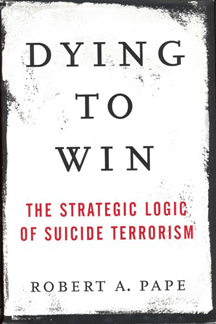
By Robert A. Pape,
Professor of Political Science, University of Chicago
[Excerpt from Dying to Win: The Strategic Logic of Suicide Terrorism by Robert A. Pape (New York: Random House, 2005, pp. 1-2, 5-7).]
Suicide terrorism is rising around the world, but there is a great confusion as to why. Since many such attacks—including, of course, those of Septemper 11, 2001—have been perpetrated by Muslim terrorists professing religious motives, it might seem obvious that Islamic fundamentalism is the central cause. This presumption has fueled the belief that future 9/11’s can be avoided only by a wholesale transformation of Muslim societies, a core reason for broad public support in the United States for the recent conquest of Iraq.
However, the presumed connection between suicide terrorism and Islamic fundamentalism is misleading and may be encouraging domestic and foreign policies likely to worsen America’s situation and harm many Muslims needlessly.
I have compiled a database of every suicide bombing and attack around the globe form 1980-2003—315 attacks in all. It includes every attack in which at least one terrorist killed him or herself while attempting to kill others; it excludes attacks authorized by a national government, for example by North Korea against South. This database is the first complete universe of suicide terrorist attacks worldwide. I have amassed and independently verified all the relevant information that could be found in English and other languages (for example, Arabic, Hebrew, Russian, and Tamil) in print and on-line. The information is drawn from suicide terrorist groups themselves, from the main organization that collect such data in target countries, and from the news media around the world. More than a “list of lists,†this database probably represents the most comprehensive and reliable survey of terrorist attacks that is now available.
The data show that there is little connection between suicide terrorism and Islamic fundamentalism, or any of the world’s religions. In fact, the leading instigators of suicide attacks are the Tamil Tigers in Sri Lanka, a Marxist-Leninist group whose members are from Hindu families but who are adamantly opposed to religion. This group committed 76 of the 315 incidents, more suicide attacks than Hamas.
Rather, what nearly all suicide terrorist attacks have in common is a specific secular and strategic goal: to compel modern democracies to withdraw military forces from territory that the terrorists consider to be their homeland. Religion is rarely the root cause, although it is often used as a tool by terrorist organizations in recruiting and in other efforts in service of the broader strategic objective.
Three general patterns in the data support my conclusion. First, nearly all suicide terrorism attacks occur as parts of organized campaigns, not as isolated and random incidents. Of the 315 separate attacks in the period I studied, 301 could have their roots traced to large, coherent political or military campaigns.
Second, democratic states are uniquely vulnerable to suicide terrorists. The United States, France, India, Israel, Russia, Sri Lanka and Turkey have been the targets of almost every suicide attack pf the past two decades, and each country has been a democracy at the time of the incidents.
Third, suicide terrorist campaigns are directed toward a strategic objective. From Lebanon to Israel to Sri Lanka to Kashmir to Chechnya, the sponsors of every campaign have been terrorist groups trying to establish or maintain political self-determination by compelling a democratic power to withdraw from the territories they claim. Even al-Qaeda fits this pattern: although Saudi Arabia is not under American occupation per se, a principal objective of Osama bin Laden is the expulsion of American troops from the Persian Gulf and the reduction of Washington’s power and influence in the region…
Since September 11, 2001, the United States has responded to the growing threat of suicide terrorism by embarking on a policy to conquer Muslim countries—not simply rooting out existing havens for terrorists in Afghanistan but going further to remake Muslim societies in the Persian Gulf. To be sure, the United States must be ready to use force to protect Americans and their allies and must do so when necessary. However, the close association between foreign military occupations and the growth of suicide terrorist movements in the occupied regions should make us hesitate over any strategy centering on the transformation of Muslim societies by means of heavy military power. Although there may still be good reason for such a strategy, we should recognize that the sustained presence of heavy American combat forces in Muslim countries is likely to increase the odds of the next 9/11.
To win the war on terrorism, we must have a new conception of victory. The key to lasting security lies not only in rooting out today’s generation of terrorists who are actively planning to kill Americans, but also in preventing the next, potentially larger generation from rising up. America’s over-arching purpose must be to achieve the first goal without failing at the second. To achieve that purpose, it is essential that we understand the strategic, social, and individual logic of suicide terrorism.
Our enemies have been studying suicide terrorism for over twenty years. Now is the time to level the playing field.
[To hear an audio clip of Dr. Pape’s book, click here.]